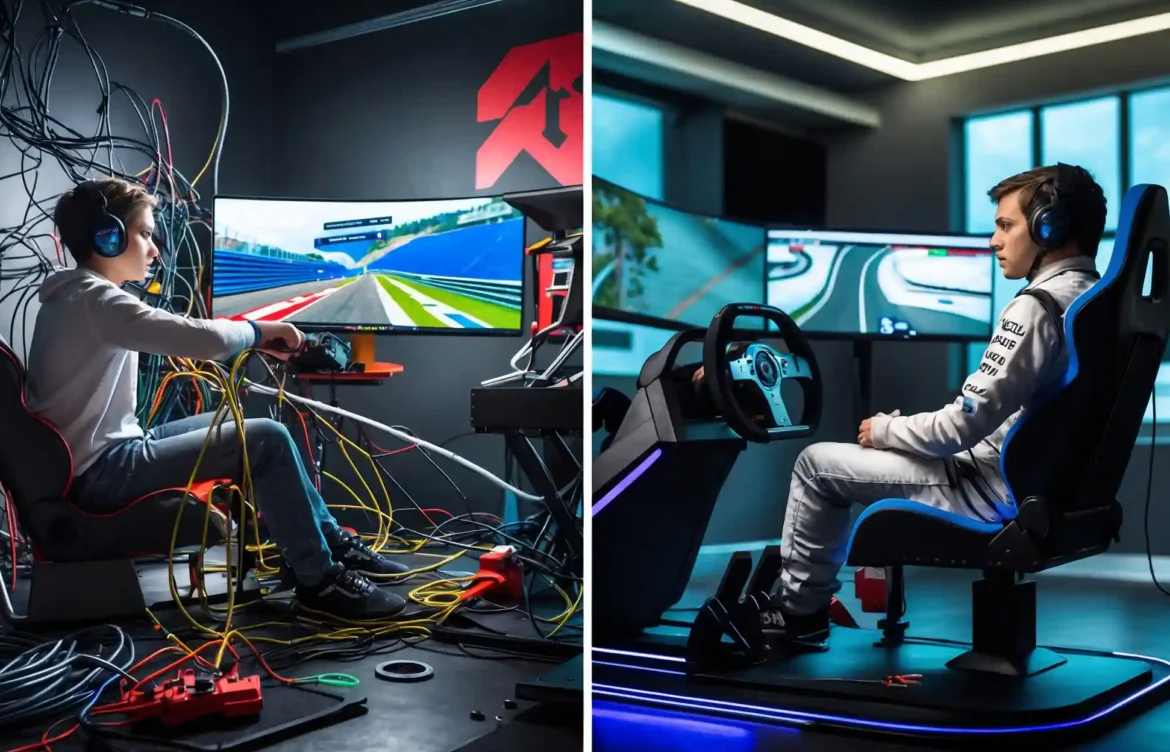
Top 8 Mistakes Beginners Make in Racing Simulator (and How to Fix Them)
You are probably here because you made a mistake while building your first racing simulator or are struggling to win in the game. A quick revision for those who are new here.
What is sim racing?
Sim racing is a type of video game that tries to make driving a race car feel as real as possible. It includes things like realistic car handling, fuel use, and tire wear. Real race car drivers sometimes use it to practice.
The active users in this gaming genre are growing enormously, with an all-time peak of more than 400,000 racers, who want the thrill of racing without the huge costs of real track time.
But here’s the thing: most beginners rush into their first racing simulator setup without knowing anything and that’s kinda natural.
Every single one of these 8 common racing simulator mistakes can be easily avoided. Gaming Tech Series has prepared this blog so you don’t have to go anywhere else.
Top 8 Common Mistakes – Short List
- Overspending
- Bad Positioning
- Poor force feedback and wheel calibration
- Wrong FOV settings
- Low-quality pedals
- Skipping track and racing line basics
- Not updating software
- Unrealistic expectations
Let’s talk about each one by one, so we can assess how we can avoid them accordingly and effectively.
Overspending on Gear
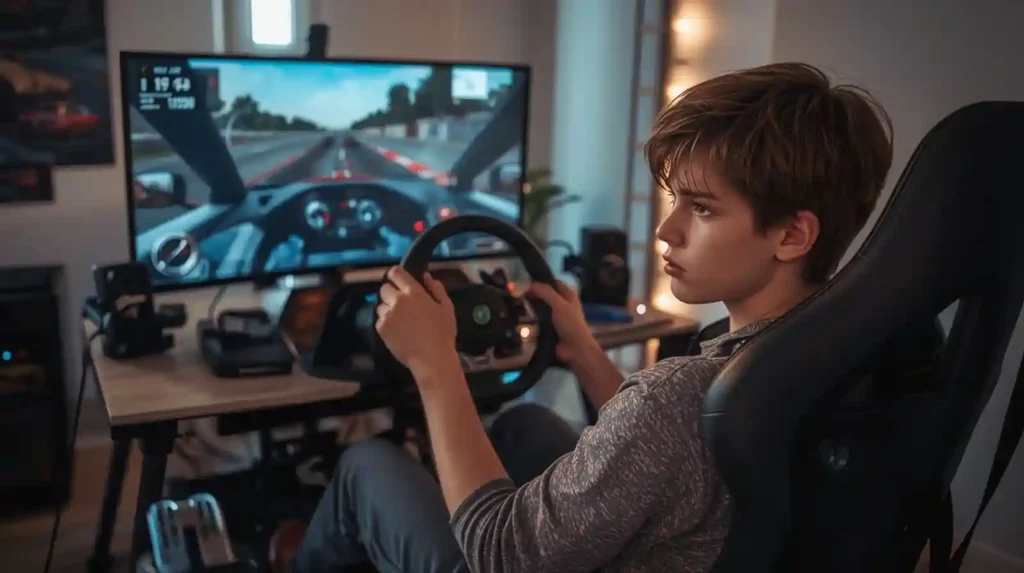
Why It’s a Mistake:
One of the most common beginner sim racing mistakes is buying expensive gear right away. It’s tempting to get high-end wheels and pedals, but they won’t make you faster if you’re still learning. Many new racers spend thousands without understanding the basics. This leads to frustration when they don’t improve. In 2025, you don’t need to break the bank. Focus on building skill first, then upgrade when you’re ready. Expensive gear helps, but only when used properly.
What To Do Instead
* Start with budget wheels like Logitech G29 or Thrustmaster T248
* Use simple pedal sets with good feedback
* Buy a stable desk or wheel stand
* Upgrade only when you’ve mastered your current setup
Poor Positioning
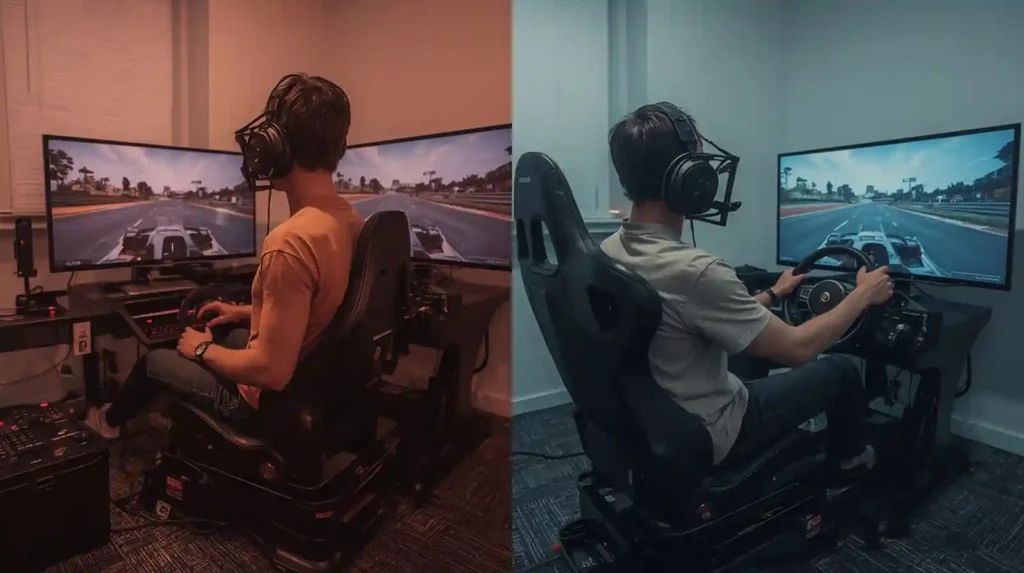
Common Posture Errors Beginners Make
| Part | Common Mistake | Better Option |
| Monitor Height | Too high or too low | Eye level, directly in front |
| Leg Angle | Knees too high or cramped | 120-degree bend with flat feet |
| Wrist Position | Overreaching or cramped | Slight bend, relaxed grip on wheel |
How to Set Up Your Racing Seat Properly
- Sit with your back straight and fully against the seat
- Adjust the seat so your knees are slightly bent
- Place your hands on the wheel with a slight elbow bend
- Keep the monitor at eye level, about 20–30 inches away
- Make sure the pedals are flat and easy to press
Force Feedback Settings Left at Default

What Happens With Wrong FFB?
Leaving the force feedback at default can ruin the driving experience. You might not feel tire grip or lose control during turns. For example, if feedback is too weak, you won’t notice tire slip until it’s too late. If it’s too strong, your wheel may feel unrealistic.
Best Force Feedback Settings for Beginners (2025)
* Assetto Corsa: Gain 100%, Min Force 10%, Filter 0%
* iRacing: Strength 8–10Nm, Damping 10%, No center spring
* Gran Turismo 7: Force Feedback Max Torque 5, Sensitivity 3
* Always turn off centering spring in software
Using the Wrong FOV (Field of View)
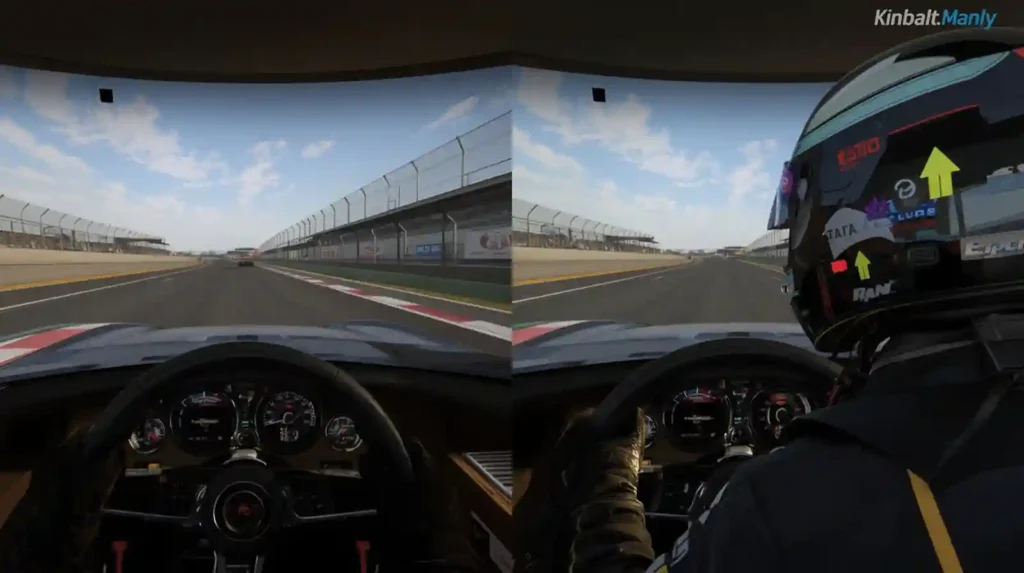
Why FOV Matters in Racing Simulator
FOV (Field of View) is how much of the track you see on your screen. A wider FOV looks cool but gives a false sense of speed. A narrow FOV may feel too slow, but it is more accurate. Choosing the best FOV settings for your racing simulator will enhance your racing experience and will probably allow you to dominate race tracks.
How to Calculate Correct FOV
- Measure your screen size and distance from it
- Go to an FOV calculator like https://dinex86.github.io/FOV-Calculator
- Enter your details
- Apply the result to your game settings
- Test and adjust slightly if needed
Neglecting Pedal Calibration
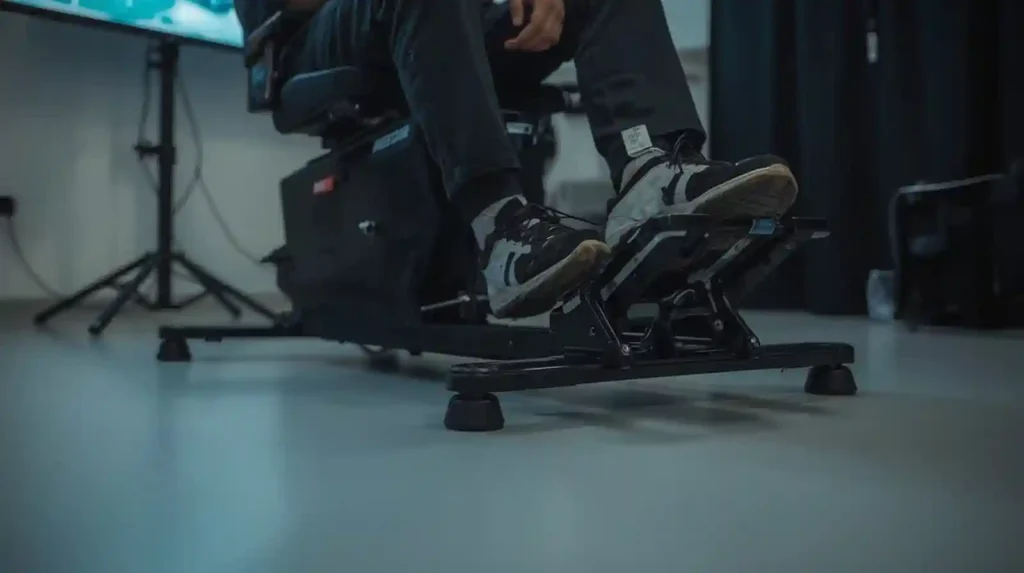
Common Pedal Mistakes
* Large dead zones cause a delayed response
* Inconsistent brake pressure
* Pedals sliding on the floor
* Unbalanced throttle and brake input
* Using plastic pedals with low resistance
Tips for Better Pedal Feel on a Budget
* Calibrate pedals after every game update
* Use Velcro strips or mats to stop pedal movement
* Add rubber stoppers or foam for brake resistance
* Try budget sets like Thrustmaster T3PA or Logitech pedals
* Adjust brake curve settings in-game if supported
Not Practicing Racing Lines or Track Familiarity
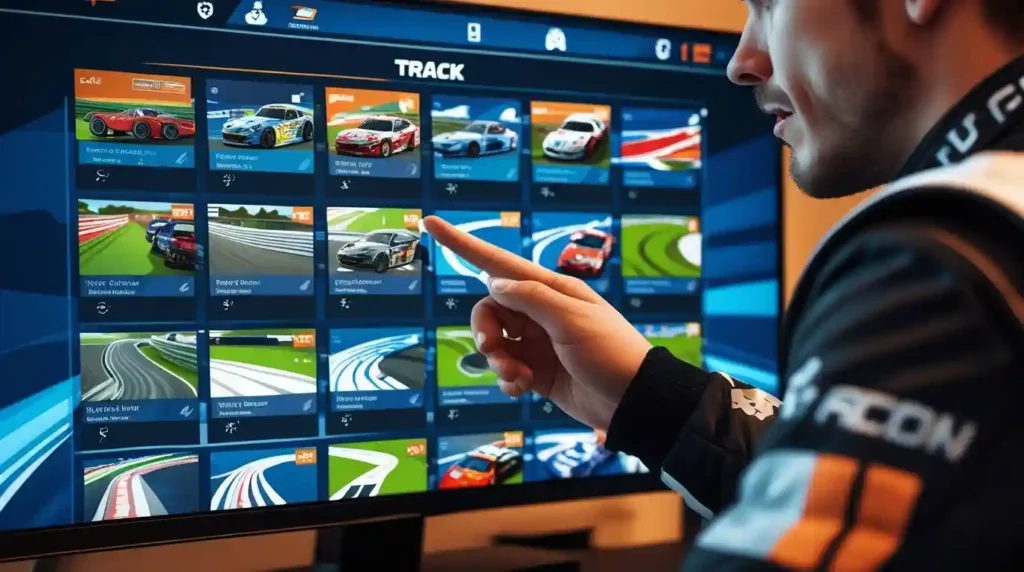
Why Jumping Between Tracks Hurts You
Switching tracks too often stops you from learning racing lines. You’ll struggle with braking points, corner speeds, and throttle control. This is a common sim racing mistake, especially for beginners. Focus on mastering one track at a time. It builds muscle memory and helps you understand car behaviour better. Without this, your lap times stay slow and inconsistent.
Simple Practice Routine for Beginners
- Pick one easy track (like Brands Hatch or Laguna Seca)
- Drive 10 laps slowly to learn corners
- Practice braking later on each lap
- Save replays and watch your lines
- Repeat daily for steady improvement
Ignoring Software Updates
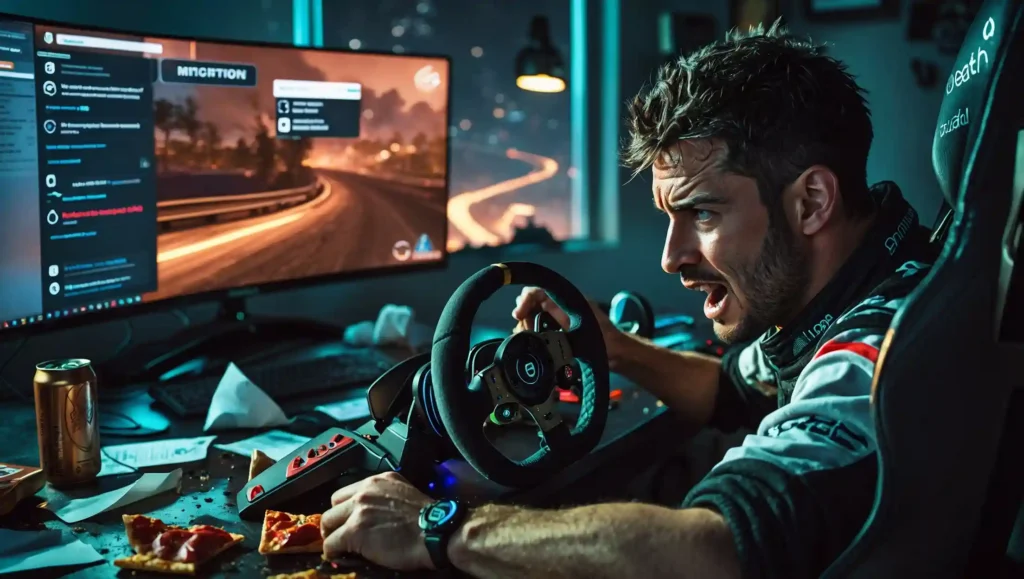
What You Miss by Not Updating
Not updating your racing simulator gear can cause serious issues. You may miss out on improved force feedback settings, better game compatibility, or bug fixes. Some pedals and wheels stop working properly if updates are skipped. Updates keep everything smooth and prevent gear problems during races.
How to Check for Updates Easily
* Logitech: Use Logitech G Hub software
* Thrustmaster: Visit their support page and use Firmware Updater
* Fanatec: Use the Fanatec Control Panel to check versions
* Always restart your PC after updating the gear
Expecting to Be Fast Instantly
The Skill Curve of Sim Racing
Sim racing is not like arcade games. It’s realistic and hard to master. Many new drivers get upset when they don’t win right away. This mindset is a big mistake. In real life, racers train for years. The same goes for beginner or pro racing simulators. You improve by being patient, learning from mistakes, and practicing regularly.
How to Measure Real Progress
* Check lap time consistency, not just best time
* Race against your own ghost laps
* Use apps like MoTeC or Delta for feedback
* Save replays and compare with faster drivers
* Track progress week by week, not daily
None can Ace Sim Racing in One Go
Sim racing takes time. It’s okay to make mistakes; we all do. What matters most is learning and getting better step by step. Don’t aim for perfection right away. Instead, focus on steady progress, clean laps, and building good habits.
If you’re just starting out, check out our beginner sim racing setup guide to help you get things right from day one. Comment down below the mistake you’ve made, we’ve all been there!
FAQs: Common Beginner Sim Racing Mistakes
- What is the most common mistake new sim racers make?
The most common mistake new sim racers make is overspending on high-end gear for racing simulator before understanding their actual needs. - Do I need an expensive wheel to get started with sim racing?
No. Entry-level wheels for your racing simulator, like the Logitech G29 or Thrustmaster T128, offer great performance for beginners. It’s better to start with budget-friendly gear and invest in a solid sim racing setup layout first. - How do I set the correct FOV in sim racing?
To set the correct FOV (Field of View), use a FOV calculator based on your monitor size, aspect ratio, and distance from the screen. This ensures a realistic perspective and better driving accuracy. A wrong FOV can throw off your spatial awareness. - Is it okay to start sim racing with a controller?
Yes, but it’s recommended to switch to a wheel as soon as possible. A racing wheel offers better control, feedback, and immersion, which helps build proper racing habits from the start. - How important is pedal calibration in sim racing?
Very important. Poorly calibrated pedals can cause braking inconsistencies and throttle control issues. Even budget pedal sets should be calibrated in-game to match your foot pressure and simulate real driving dynamics. - What’s the best way to improve as a beginner sim racer?
Practice consistently on a single track and car combo, learn racing lines, and watch onboard laps or ghost data. Joining beginner racing communities can also accelerate your learning. - What sim racing games are best in 2025?
Some beginner-friendly racing sims in 2025 include: Assetto Corsa, Gran Turismo 7, Forza Motorsport, and iRacing (for those ready to go competitive). - How can I avoid getting overwhelmed when starting out?
Stick to one game, one car, and one track. Don’t rush to upgrade your racing simulator gear. Learn the basics, join online forums, and celebrate small improvements like lap consistency and clean racing.
